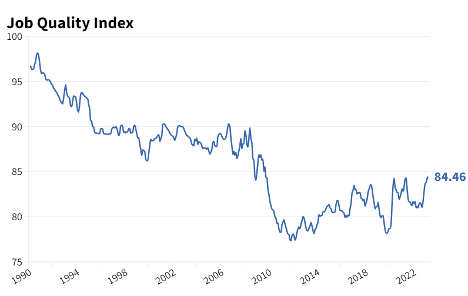WASHINGTON — The Coalition for a Prosperous America (CPA) today announced that the U.S. Private Sector Job Quality Index (JQI) for April was 84.46, up 0.25% from March. A month ago, it looked like the job market was beginning to plateau, but upward revisions to March’s data means the JQI was 0.48 higher than reported. In other words, what looked like a labor market beginning to stall out a month ago was instead continued growth of high-quality jobs relative to low-quality jobs in the economy.
The average weekly wage for production and nonsupervisory workers in April was $969.09, up 0.25%. Wage growth over the past year of 4.1% remains below the rate of inflation of 4.9%, meaning that consumers’ purchasing power continues to erode. Wage growth was stronger than average among high-quality jobs which saw an increase of 0.60%, or $7.87 in weekly wages. Recent months showed little wage growth but the most recent data shows wage growth resuming, although not as strong as a year ago.
High-quality job growth was strongest in construction, which added 17,400 jobs and an increase in wages of $12 per week. Health care and social assistance added 66,800 jobs, nearly twice as many jobs as the sector added last month, but once again two-thirds of the jobs added in the sector were low-quality jobs. Education added 23,700 jobs, of which three-quarters were high-quality jobs.
The Bureau of Labor Statistics (BLS) reported overall job gains of 339,000 in May and an unemployment rate of 3.7%, up 0.3 percentage points. Employment figures for March and April were revised upward by a combined 93,000 jobs. Topline hiring figures remain strong and continue to exceed expectations despite the rise in interest rates by the Federal Reserve.
Yet, recent job gains are increasingly concentrated in the services. Manufacturing lost 2,000 jobs in May. Month-to-month revisions can be noisy, but the past three months of data show hiring in manufacturing has contracted by 4,000 jobs. Goods-producing industries account for only 9% of the job gains in May, down from 11% in April and almost all goods-producing hiring was concentrated in construction. A year ago, goods-producing industries accounted for 18% of private sector job growth with manufacturing accounting for about one-third of the goods-producing job growth. High-quality job growth is not as broad based as it was a year ago.
The Job Quality Index measures job quality for U.S. production and non-supervisory workers by comparing workers’ weekly wages to the mean weekly wage for all non-supervisory workers. Those jobs above the mean are classified as high-quality and those below the mean are low-quality. The index is calculated by dividing the number of high-quality jobs by low-quality jobs. An index of 100 means the number of high-quality production and nonsupervisory jobs is equal to the number of low-quality jobs. An index below 100 means that the economy includes more low-quality than high-quality jobs.
Over the past three decades, the JQI declined because the U.S. economy created more low-quality jobs than it has high-quality jobs. As shown in Figure 1, the JQI is down 12.7% from 1990 illustrating the disproportionate growth in low-wage, low-hour jobs.
Figure 1. Job Quality Index 1990-2023













